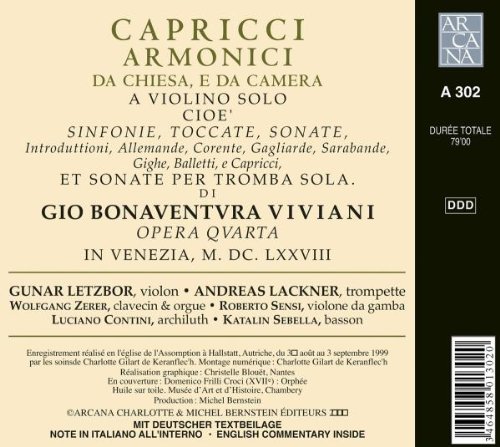
kompozytor
Viviani, Giovanni Buonaventura
tytuł
Viviani: Capricci Armonici op. 4
wykonawcy
Letzbor, Gunar;
Contini, Luciano;
Lackner, Andreas;
Zerer, Wolfgang;
Sebella, Katalin;
Sensi, Roberto
Contini, Luciano;
Lackner, Andreas;
Zerer, Wolfgang;
Sebella, Katalin;
Sensi, Roberto
nr katalogowy
A 302
opis
THE NEW VINTAGE VIOLIN
In the history of the resurgence of period instruments, the harpsichord and organ or the viol and lute have found their predestined interpreters more rapidly than the violin or cello. Doubtless because habits have relegated the culture of the return to sources to the rejects heap of the modern instrument. Long have I regretted that a Baroque repertoire as abundant as it is marvellous has had to remain ignored due to a lack of interpreters sufficiently transcendent to bring it to light. Twentyfive years ago, it was necessary to choose between Baroque violinists of uncertain technique or modern violinists who took up the ancient violin without any research work, style or inspiration, solely because the Baroque was in vogue and constituted an obligatory passage for making a name for oneself.
We thus had to wait and leave it to the first apostles, such as Sigiswald Kuijken, to preach in reprobation before recognition, in order to see the dawning of a new thinking generation that equipped itself with the appropriate technique. In turn, masters of the stature of an Enrico Gatti or a Gunar Letzbor joined the movement with an impetus provided by Arcana, and it is henceforth possible to carry out true thorough-going work on the repertoire, thus creating this point of no return from which ideas and knowledge can no longer turn back.
GUNAR LETZBOR is Austrian. With his great height, impressive on stage, the violin he holds in his hands seems small in comparison. But as soon as he plays, he unleashes a power that finds its full dimension in the artists incredible mastery, drawing undreamed of colours and dynamic shadings; this is playing that is simultaneously full and fragile. Letzbor’s technique is so sovereign that his detractors – those who persist in thinking that the Baroque repertoire is the property of amateurs – would like to relegate him to Romantic music, where his transcendent technique would not cause them the affront of exposing their shortcomings. But that only demonstrates how poorly they know this artist. For Gunar Letzbor, playing is an existential, charismatic act that demands a culture and its atmosphere: those of this crucible of Europe which is called Austria, and which weaves links with its neighbours so ambiguous that they unravel as soon as one perceives them. A technician, certainly, but a technique at the service of thinking nourished by an accepted culture and the manner in which the artist feels his life. For his is a tortured, sombre, subjective temperament, never at rest, always on a quest for music in evolution. There is in Letzbor a search for expressiveness that can become poignant, and it is not by chance that he has made Bibers Sonatas of the Rosary the heart of his repertoire: this masterpiece of the heartrending drama is the reflection of his soul.
When Gunar Letzbor spoke to me about the idea of recording Vivianis Opus IV, I was not even familiar with the composers name. But the way he described him, I knew that he had penetrated all the mysteries to recreate this evolutive, contrasted music, in turn bewitching or stirring. Viviani was a late 17th-century Florentine composer who spent a good part of his life at the Court of Innsbruck, an Italian influenced by Austria (Schmelzer, Biber, et al.), the mirror image of the Austrian Letzbor who lives in Italy. Vivianis biography contains many shadows and uncertainties, but no matter! His music is rich and dense, and these interpreters impassioned; the team brought together by Letzbor for the continuo is in his image: committed, virtuoso, poetic and enthusiastic, with special mention for trumpeter Andreas Lackner, one of the finest of the moment.
MICHEL BERNSTEIN
nośnik
CD
gatunek
Muzyka klasyczna
producent
Arcana
data wydania
15-12-2011
EAN / kod kreskowy
3464858013020
Produkt nagrodzony:
Classica - 'R10'
Crescendo: 'Joker'
Diapason: 5 diapasons

(Produkt nie został jeszcze oceniony)
cena 79,00 zł
lubProdukt na zamówienie
Wysyłka ustalana indywidualnie.
Darmowa wysyłka dla zamówień powyżej 300 zł!
Darmowy kurier dla zamówień powyżej 500 zł!
sprawdź koszty wysyłki



































